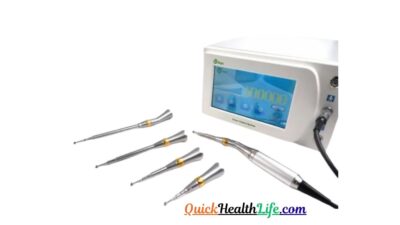What is Pulse Lavage?
When it comes to wound cleaning and infection control, Pulse Lavage is one of the most effective techniques. It is a medical procedure where pressurized streams of fluid are used to irrigate (clean), debride (remove dead tissue), and wash wounds.
It is widely used in orthopedic surgeries, trauma care, chronic wound treatment, and infection prevention. Pulse lavage systems are designed to reduce bacterial load, remove debris, and promote faster wound healing.
Table of Contents
Pulse Lavage Procedure
Pulse lavage irrigation is usually performed by a trained healthcare professional (doctor, nurse, or wound care specialist). Here’s a step-by-step process:
- Preparation
- Patient’s wound is exposed.
- Protective drapes are applied to avoid splashing.
- Sterile saline solution or antiseptic solution is prepared.
- Device Setup
- A pulse lavage irrigator (handheld device) is connected to a fluid source.
- The device is powered (battery or electric).
- Irrigation
- Pressurized pulses of saline are directed at the wound.
- The pressure can be adjusted depending on wound type (low, medium, or high).
- Debridement
- Dead tissue, dirt, pus, and debris are loosened and washed away.
- The device may have a suction system to remove contaminated fluid.
- Wound Assessment
- The wound is inspected for cleanliness.
- Dressing is applied to protect the site.
Types of Pulse Lavage
There are different types of pulse lavage systems depending on use:
- Low-Pressure Pulse Lavage
- Pressure: 4–15 psi
- Used for delicate wounds, ulcers, and soft tissue injuries.
- Medium-Pressure Pulse Lavage
- Pressure: 15–25 psi
- Used in moderate wounds, trauma cases, and surgical wounds.
- High-Pressure Pulse Lavage
- Pressure: 25–70 psi
- Common in orthopedic surgeries, bone cleaning, and infected wounds.
What are the Two Purposes of Using Pulse Lavage?
The main purposes of pulse lavage are:
- Irrigation (Cleaning): Removes debris, bacteria, blood clots, and contaminants.
- Debridement: Helps in removing dead tissues, preventing infection, and promoting healing.
What is a Pulse Lavage Irrigator?
A pulse lavage irrigator is the handheld device used in the procedure.
- It generates controlled pressurized streams of fluid.
- Most modern systems also have suction attachments.
- Brands like Stryker Pulse Lavage are popular in hospitals.
Pulse Lavage Uses
Pulse lavage is used in many areas of medicine:
- Orthopedic surgeries – cleaning bones during fracture repair or joint replacement.
- Wound care – diabetic ulcers, burns, bedsores.
- Trauma management – road accident injuries with contaminated wounds.
- Infection control – removing bacteria from wounds.
- Debridement – clearing necrotic (dead) tissues.
Pulse Lavage Contraindications
Pulse lavage should not be used in:
- Exposed arteries, veins, nerves, or organs (to avoid damage).
- Tunnels or sinus tracts in wounds (fluid may get trapped).
- Patients with bleeding disorders (risk of excessive bleeding).
- Over fragile tissues (can cause damage).
Pulse Lavage Wound Debridement
One of the most important uses of pulse lavage is wound debridement.
- It removes slough, necrotic tissue, pus, and infection-causing debris.
- It reduces bacterial count and speeds up healing.
- It is less painful compared to traditional scrubbing methods.
Pulse Lavage vs Other Irrigation Techniques
- Pulse Lavage → Uses pulsating pressurized streams (more effective).
- Normal Saline Wash → Uses gravity flow or syringe (less effective).
- Hydrosurgery Systems → High-speed water jet (expensive, complex).
Pulse Lavage in Orthopedics
In orthopedic surgery, pulse lavage is used to:
- Clean bones before implant placement.
- Reduce infection during joint replacement surgery (hip, knee).
- Remove bone marrow and fat from intramedullary canals.
Pulse Lavage PPT
If you are preparing a Pulse Lavage PPT presentation, here are the main slide headings:
- Introduction to Pulse Lavage
- History and Development
- Principle of Pulse Lavage Irrigation
- Types (Low, Medium, High Pressure)
- Indications & Contraindications
- Step-by-Step Procedure
- Devices & Irrigators (Stryker, etc.)
- Clinical Uses in Wound Care & Orthopedics
- Advantages & Limitations
- Cost & Availability in India & Abroad
Pulse Lavage Systems and Brands
Some popular brands:
- Stryker Pulse Lavage – widely used in orthopedics.
- Zimmer Biomet Pulsavac Plus – advanced irrigation system.
- Smith & Nephew RenaPulse – lightweight and portable.
- Disposable systems – cost-effective for wound care clinics.
Pulse Lavage Price & Cost in India and Abroad
The cost of pulse lavage depends on brand, usage, and accessories.
- Pulse Lavage Device Price in India: ₹25,000 – ₹80,000 (depending on brand).
- Disposable Pulse Lavage Kits: ₹500 – ₹2,000 per procedure.
- Stryker Pulse Lavage System Price: ₹50,000 – ₹1,00,000 (hospital-grade).
- Cost Abroad (USA/Europe): $500 – $1,500 per unit.
👉 For patients, the procedure cost in hospitals ranges from ₹2,000 – ₹8,000 depending on wound type and hospital charges.
Advantages of Pulse Lavage
- Effective wound cleaning.
- Faster recovery compared to traditional irrigation.
- Reduces bacterial load.
- Less painful for patients.
- Easy for healthcare staff to use.
Disadvantages of Pulse Lavage
- High cost of equipment.
- Splash risk (requires protective gear).
- Not suitable for all wounds.
- Disposable parts increase expenses.
Latest Research on Pulse Lavage
Recent studies suggest:
- Antimicrobial solutions in pulse lavage reduce infection rates further.
- Single-use disposable systems are safer for infection control.
- Low-pressure systems may be more suitable for chronic wounds than high-pressure ones.
FAQs on Pulse Lavage
Q1. What is Pulse Lavage?
Pulse lavage is a wound cleaning technique using pressurized fluid streams for irrigation and debridement.
Q2. What are the two purposes of Pulse Lavage?
- Irrigation (cleaning)
- Debridement (removing dead tissue)
Q3. What is a Pulse Lavage Irrigator?
It is a handheld medical device that delivers pulsed fluid streams for wound irrigation.
Q4. What are the contraindications?
Not used on exposed arteries, nerves, or fragile wounds.
Q5. How much does Pulse Lavage cost in India?
Between ₹2,000 – ₹8,000 per procedure; devices cost ₹25,000 – ₹80,000.
Conclusion
Pulse Lavage is a revolutionary method in wound care and orthopedic surgeries. It improves healing, reduces infection, and ensures effective debridement. With brands like Stryker and Zimmer, hospitals worldwide are adopting it.
As a healthcare blogger, I, Umesh Yadav, have seen how important pulse lavage irrigation systems are becoming in both India and abroad. For patients and medical professionals, it offers a safe, effective, and advanced solution in wound management.



